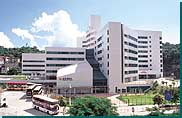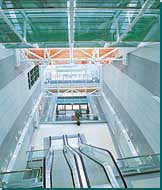| December
2000 |
 |
|
|
Tseung Kwan O Hospital
Healing
concepts
In the heart of the fast-developing
Tseung Kwan O New Town is a new acute general hospital surrounded
by residential high rises. Tseung Kwan O Hospital, however, gives
little away of its clustered surroundings, set as it is against
the verdant backdrop of a low hill, with extensive landscaped open
space in front framing the interlocking forms of the complex.
 "We
included a lot of landscaping to make it attractive in what is otherwise
a very urban area," explained David Foxley, director of projects
at TPS Consult, the firm responsible for developing the specifications
for the project. "We
included a lot of landscaping to make it attractive in what is otherwise
a very urban area," explained David Foxley, director of projects
at TPS Consult, the firm responsible for developing the specifications
for the project.
To
ensure that the hospital would blend in with the leafy setting,
green tinted strips of windows were deliberately chosen to complement
ceramic tiles in a pale shade of green.
"We
didn't
want huge glass walls as they wouldn't
fit into the surrounding area or the concept of a hospital. Huge
glazed areas would also increase the cooling load, but they've attractive
in small quantities," Mr Foxley said.
The
hospital comprises five blocks: three ten-storey high ward blocks,
which are set behind a six-storey clinic block and a five-storey
rectangular diagnostic and treatment block. A central circular core
links the blocks together to create a complex of interlocked geometric
forms.
The
different heights of the blocks not only make the complex more interesting,
but also create roof space for landscaped recreational facilities.
A pergola was created on the fourth floor podium of the diagnostic
and treatment block. In addition, the geriatric wards in the east
block and the paediatric wards in the north block are both provided
with direct access to their own gardens or play area.
Landscaping
is also used in the public areas surrounding the hospital to define
pedestrian and vehicular access, improve the appearance of the open-air
car park and mask the morgue.
The
main pedestrian access to the hospital is addressed by a four-storey
atrium. Covered by a skylight equipped with sunshading devices,
the atrium leads visitors to the main lobby via two sets of escalators,
providing a clear path of travel which minimises the chance of visitors
getting lost. To further assist visitor orientation, the blocks
are colour-coded.
Triangular ward
configuration
The most notable feature of the hospital is the three triangular
ward blocks, which provide a total of 598 beds, including 140 day
beds. With wards on three sides arranged around a nurse station
in the middle, the user-friendly layout allows nurses a view of
every patient bed from their central position.
Another
advantage of the design is that, unlike traditional hospitals where
medical staff have to patrol up and down long corridors, the triangular
layout vastly reduces the distance nurses have to walk in order
to reach every bed, thus minimising the fatigue they experience.
Finally, the layout makes it possible for a small staff to serve
a relatively high number of patients without undue stress, thus
improving operational efficiency. Mr Foxley said the ward blocks,
which produce a windmill plan, also drove the shape of the hospital,
generating an architecturally interesting building.
Other
facilities are also arranged to be as user-friendly as possible.
Wards catering for a particular type of patients are located on
the same floor as the outpatient clinic dedicated to the same type
of patients. To provide the fastest treatment possible, direct access
is provided between the operating theatres and the intensive care
unit. The accident and emergency department is located close to
the radiological department to facilitate diagnosis.
Tseung
Kwan O Hospital is the first hospital in Hong Kong to be developed
under a design-and-build contract. According to Mr Foxley, the Hospital
Authority decided to adopt this form of contract because of the
speed and certainty of completion it promised.
"Normally
it would take about ten years to develop such a hospital; this one
was completed in five," Mr Foxley pointed out.
Unlike
design-and-build projects where the contractor is selected and left
to work with his architect in developing the design, TPS started
with a firm concept and worked closely with the contractor and architect
in ensuring that the concept was realised. The triangular ward system
was among the key elements which the successful tenderer was required
to incorporate into his design. Another one was energy efficiency
-- a stipulation which resulted in use of a sophisticated temperature
control system with 2,000 monitoring points, low wattage lighting,
and dual fuel boilers capable of using oil as well as gas.
End-user input
Appointed by the Hospital Authority to project-manage the project,
TPS was responsible for not just developing the brief and evaluating
the tenders, but also for obtaining the input of end-users concerning
their requirements. As the hospital had yet to be built at that
stage and therefore did not have any staff of its own, end-users
were "borrowed" from other hospitals to lend their experience
to the design process.
The
process began with the contractor dividing the hospital into different
departments and producing drawings on a room by room basis. These
were then presented to the end-users to be signed off, if they agreed
that the drawings represented what they wanted.
Attention
was paid to every detail. For example, in designing the maternity
ward, how the rooms were set out, where delivery rooms would be
placed and even where the scrub sinks would be were all discussed
and finalised with the help of the doctors and nurses whose colleagues
eventually moved into the built complex. More than 100 end-users
were involved in signing off 150 sets of drawings.
"In
a way the hospital was almost designed by the end-users," Mr
Foxley observed.
Due
to the building services requirements of a hospital, the complex
has a generous headroom of 4.5 m. Among the services provided is
a fully automated pneumatic tube system which links all the departments
together. Tubes sent from any department go to a central server
located in the above-ground "basement" (due to the high
water table the hospital was built on a platform which subsequently
housed the basement at street level), from which they are directed
to their destinations in a matter of minutes.
Built
at a cost of HK$1.2 billion, the 60,000 sq m hospital is designed
to serve a population of 300,000 in the new town. Occupying the
eastern corner of the 3.7 ha site, the hospital was developed with
a view towards expansion some time in the future, with a 50 per
cent increase in the number of beds.
Construction
was completed in April 1999 and various sections have been progressively
commissioned, beginning with several specialist outpatient clinics
in December of that year. The accident and emergency department
began service in July this year.
client Hospital Authority
project manager TPS Consult Asia Ltd
architect (design concept) Wayne Fishback & Associates
architect (detailed design) Kwan-PTP Architects & Hospital
Planners Ltd
structural engineer Ove Arup & Partners (HK) Ltd
building services engineer Parsons Brinckerhoff (Asia) Ltd
quantity surveyor Levett & Bailey
main contractor Laing-Hip Hing Joint Venture
|

 "We
included a lot of landscaping to make it attractive in what is otherwise
a very urban area," explained David Foxley, director of projects
at TPS Consult, the firm responsible for developing the specifications
for the project.
"We
included a lot of landscaping to make it attractive in what is otherwise
a very urban area," explained David Foxley, director of projects
at TPS Consult, the firm responsible for developing the specifications
for the project.